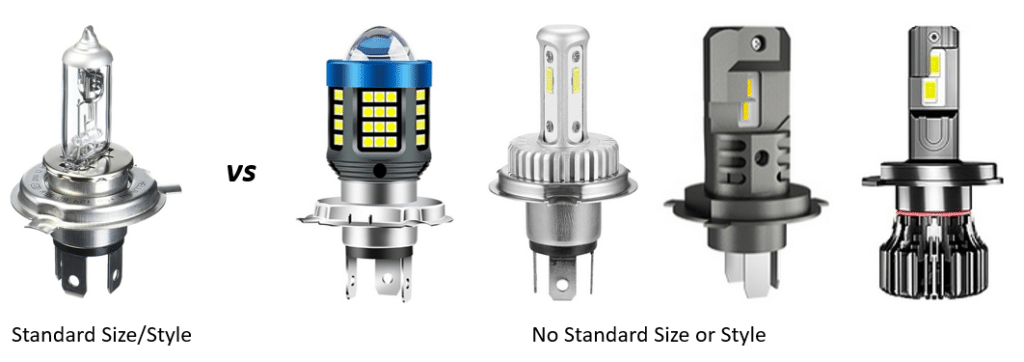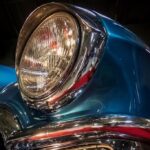Legality of replacement LED lights
The legality of replacement LED lights for vehicles has been a subject of debate among car owners. Motor vehicle regulations can be cryptic and vary from country to country, causing inconsistencies and confusion. In this comprehensive guide, we will delve into the legality of replacement LED lights, exploring different scenarios and regulations. By the end, you will have a clear understanding of when and where you can use LED lights as replacements for your vehicle.
Complete Headlight Assemblies
LED headlights for vehicles used on-road are legal when the complete assembly has been designed, tested, and certified by the light manufacturer to meet all Federal Motor Vehicle Safety Standards (FMVSS) 108 requirements, when used solely off-road there are no standards. These requirements include stringent photometry testing, vibration resistance, water and dust ingress resistance, humidity exposure, chemical and impact resistance, labeling, and various other tests.
It’s important to note that there are many aftermarket manufacturers who fraudulently certify their products as legal, even when they don’t meet the strict FMVSS 108 standards. To ensure compliance, you can check the NHTSA MID database, which lists registered manufacturers of components regulated under all FMVSS. KnightBeam, for example, is fully transparent and registered with the NHTSA, providing confidence in the legality of our products, you can search for our registration at the link below.
Replacement Headlight Bulbs
When it comes to replacing bulbs in halogen or HID headlight assemblies with LED bulbs for vehicles used on-road, the usage of LED bulbs is expressly forbidden in the United States. Even if a seller claims that their LED bulbs can produce a legal beam pattern in a halogen headlight housing, it is still considered illegal. There are many reasons behind this, with the major one being the lack of standardization within the LED manufacturing realm, resulting in different shapes, sizes, wattages, labeling, and beam patterns of LED bulbs with the same base (FIG 1).

While it is true that some high-quality LED bulbs may produce a legal beam pattern in halogen housings, the lack of standardization makes it difficult for the US and Canada to set clear regulations for their usage. As a result, the government’s default response is to deem these conversions as illegal. However, it’s worth noting that other countries, such as Germany, have made LED conversions in halogen headlight housings legal by implementing testing and certification programs through independent third-party entities.
All Other Lights
Replacement LED bulbs used for vehicle lighting locations other than headlights, such as tail lights, brake lights, turn signals, fog lights, and auxiliary lights, are generally legal to use in the United States. These bulbs have not faced significant complaints to the NHTSA, and their usage is often considered to enhance safety due to reduced bulb illumination time, thereby alerting following drivers of the leading driver’s intention to change lanes or stop sooner, thus reducing the potential for rear-end collisions.
Different lights have different requirements depending on their function and placement on the vehicle. Photometric standards vary accordingly, with headlights having the most stringent standards. The Code of Federal Regulation (CFR) FMVSS 108 provides comprehensive information on these standards, and is accessible online.
The table below summarizes the legality of replacement LED bulbs for different vehicle lighting locations:
The below table helps to clarify when a replacement LED bulb is legal to use.

Outdated Headlight Laws and Potential Future Revisions
US headlight laws are considered extremely outdated compared to most other first-world countries that have embraced newer technologies. LED light conversions are one of those technologies that are waiting for regulations to catch up. However, there is hope for change.
Section 24212 of HR 3684, known as the Infrastructure Investment and Jobs Act, was signed into law on November 16, 2021. This act states that the Secretary shall issue a final rule amending Standard 108 within two years. The aim of this revision is to create a path for newer technologies to be adopted in the US and provide a framework for LED bulb manufacturers to legally certify their products for halogen or HID headlight assemblies.
Germany has already made progress in legalizing LED conversions by implementing testing and certification programs conducted by independent third-party entities like TÜV-Süd. These programs ensure that LED products work effectively in specific halogen housings, resulting in high-quality and legal LED conversions available to the public.
The underlying reasons for LED lights not being legal in the US are twofold. Firstly, the lack of standardization and inconsistent designs from LED manufacturers and importers contributes to the uncertainty surrounding their performance and legality. Secondly, the outdated FMVSS 108 laws need revision to accommodate newer technologies and ensure the production and use of safe and compliant products. A collaborative effort between federal regulators and the automotive lighting industry is crucial to enforce the use of well-built, quality products while keeping unsafe manufacturers out of the market.
Conclusion
In conclusion, the legality of replacement LED lights depends on various factors, including the type of assembly, specific lighting locations, and adherence to federal or municipal regulations. Complete LED headlight assemblies must meet FMVSS 108 requirements and be certified by the manufacturer to be considered legal. On the other hand, replacing only the bulb in halogen or HID headlight assemblies with LED bulbs is illegal in the US, due to the lack of standardization, poorly designed products, and clear regulations.
For other lighting locations such as tail lights, brake lights, turn signals, fog lights, and auxiliary lights, replacement LED bulbs are generally legal. These bulbs can enhance safety by reducing the illumination time and alerting following drivers of the leading driver’s intentions sooner.
While the US headlight laws may be outdated, recent legislation signals the possibility of future revisions to accommodate newer technologies. Other countries have already made progress in legalizing LED conversions through testing and certification programs. It is important for federal regulators and the industry to work together to ensure the production and use of safe, compliant LED lights for vehicles.
By understanding the regulations and purchasing products from transparent and registered manufacturers, vehicle owners can make informed decisions and ensure compliance with the applicable laws regarding replacement LED lights for their vehicles.
References



